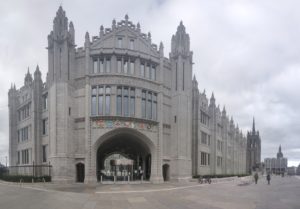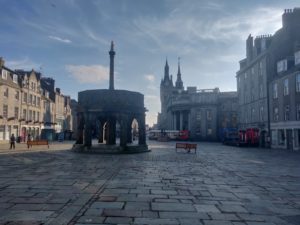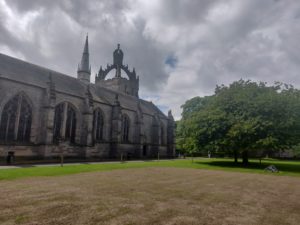I recently attended the ITiCSE Conference in Aberdeen.
Doctoral consortium
A doctoral consortium is a group of PhD students getting together. It is Interesting to see what everyone else is doing. From what I gathered, it seems like everyone is more organised than I am. But at the same time, it’s still a bit reassuring to heat that a lot of the issues being encountered are the same as mine.
The DC organisers had set up a jigsaw for during breaks which was a nice touch. More events need to have jigsaws.
Working Groups
My phone tried to auto correct this to “lurking groups”, which is maybe a more accurate title.
As part of the DC, we got to briefly join a working group that was preparing something for the main conference. My experience consisted of a lonely literature search for an hour. To put it mildly, that’s not my favourite thing to do.
We also got assigned to smaller mini working group sessions specifically amongst the DC students. This was a bit more interesting, but I’m not really sure what to make of it. As a group of 4 we produced a short presentation, but I don’t really know if it is really worth much in the long run. It seemed to be more of a social and networking exercise than anything.
I did talk to a lot of people (I could count them on one hand, but it’s a lot for me). Networking is hard but can lead to sharing of interesting ideas.
Main Conference
Day One
The first day of the conference had some interesting talks. The opening keynote was by Kate Stone of Novalia. She talked about how she set up a company that makes interactive things. That’s not really my thing, but apparently people engage really well with it.
The next session was on struggles faced by novice programmers. Discussion around the two systems of mind (Fast & Instinctive vs Slow & Logical) and the problems that arise when you don’t make good balance between both. The idea of a “Computer Science Concept Inventory”, and how you could use it to quickly spot and address common pitfalls early on. Also, looking at some examples of tracing execution (with pencil and paper), and seeing what such traces reveals about the learners that drew them. Apparently students who start a trace and then stop half way through do worse when answering questions about algorithms than students who don’t draw a trace at all.
The main sponsor, GitHub, gave its advertisement talk at lunchtime. It was interesting to see the approach taken, but my university uses GitLab and I get the impression our solution is superior. Though I may be biased. It did bring up some interesting ideas that would be worth implementing on our part.
There were some results from studies in classrooms around the demographics of a new apprenticeship program introduced in Scotland (we need more diversity), and how a class of students seemed to benefit from a leaderboard gamifying good quality code (the students stopped writing good quality code when the leaderboard was taken away which is disappointing).
The afternoon sessions were about pair programming. This is often used well in industry, but a recent study has shown that it doesn’t necessarily have as great a benefit in academia as commonly assumed. An interesting find is that the inclusion of a female student in a pair offers a greater benefit to FF and MF pairs than just MM on its own. Again this shows the need for more diversity in gender in CS education.
Day Two
The talks I attended on the 2nd day were more focused about experiences in actual CS classrooms and courses. Lots of “Fun” ways to get students interacting and learning, some of which actually seemed fun.
Games such as building breakout on an Arduino and using Lego robot programming as an icebreaker for new entrants on a course. These seemed like the most interesting ideas – I would have liked to see them in my undergraduate course. There was also a serious game to teach pointers – something the speaker called a “Threshold Concept” – No word yet on how this would impact learning in the long term though.
There were also a number of talks about tools to assist in education and research. CS Ed Research, Snap, and plenty of automation tools.
The Conference Banquet was that evening. No pictures, as I’m not one to photograph my food before I eat it – I’m to greedy to be patient for that. Good Haggis, neeps & tatties. Mediocre miscellaneous “chicken dish”. Good sticky toffee & ice cream. There was also a ceilidh, so I partook in one dance. I’ll be damned if I let those wasted hours learning this stuff in school go unused.
Day Three
The keynote opening day three was by Marian Petre. She was presenting an overview of the work that she has done in software design. She observes that “expert” designers explicitly ignore many of the common conventions that students are taught, or at the very least they adapt them sometimes beyond recognition. The observations reveal an interesting problem: structured methods for design are necessary in order to get a good grounding in the theory before you can begin to think to adapt them, but at what point do you suggest people start adapting it? If someone does this before they are ready, it would have detrimental effects.
I attended some of the presentations from the working groups. The most interesting to me was one discussing the problems with textual error messages. Mostly these seemed to want to gather and organise existing literature and content in their various fields to make it easier to use later. I would think it would be better if this were organised to begin with, but that doesn’t seem to happen. I wonder why?
The afternoon had some sessions discussing programming practice on classrooms. Some “digital storytelling”, which is often used in school education, was trialled in a university course, and had some benefits like easily revealing misconceptions. Though it looks like a lot of work which could be (maybe better?) spent on active coding exercises. Also, some research on copying and mimicry and why it isn’t necessarily bad from a teaching standpoint.
There was an interesting suggestion of using automated prompts to highlight potential security issue to students given by analysing commits. An interesting idea, but it would need to be studied on a large scale. After this there was a talk about how a visualisation tool for integer representation was developed for a course. Visualisation is good – the tool looked a bit confusing, when it was eventually shown.
Overall a lot of the talks had good ideas, even if there were a few duds I didn’t follow well.
Aberdeen
Perhaps its because I was recently in Stockholm, but Aberdeen seemed underwhelming at first. At least from what I saw, anyway. It looks like your generic Scottish city. If you go wandering though, eventually you find that some of the buildings do look very impressive.

I think what bothered me, and it took me a while to figure out, was the fact that in the city centre everything is grey. The buildings must all be made of the same kind of stone because its just shades of gray everywhere you look.

The university campus where the conference was located is very nice. It has visibly kept its roots with lots of old buildings mingled amongst the new. It can be a bit awkward though as these older buildings are not exactly designed for modern use. Think power sockets, seating and ease of access.

When you find it, the walks around the River Don and the beachfront are very nice, especially in the warm weather I was experiencing (topping out at 20C which is pretty good for North Scotland).
For food and drink there are a lot of pubs everywhere. Restaurants seem to be a bit harder to come by, but there are plenty as well if you look hard enough.
I can recommend the Arkaig Guest House if you ever want to visit Aberdeen. Very nice, friendly and comfortable.
Summary
All told, this was a nice trip. It was good to have a property visit in Aberdeen. The ITiCSE next year is in Norway and I think I would like to go again, assuming it is still relevant to me.





Thanks for sharing your experience about ITiCSE. Aberdeen looks really beautiful. If you go next year in Norway, please come and say hi to us as well, we’ll try to get some jigsaws as well for the breaks in the office… 😉
Also why do you prefer GitLab over GitHub? It’d be interesting to hear for the non-GitLab users (like me 😇) the differences between these two solutions.
The biggest different between GitLab and GitHub is that GitLab is open source which has multiple benefits – it’s cheaper (free, minus some of the more obscure features), it’s easy to self-host, and it’s also easy to start tinkering with.
The next biggest difference is that GitLab has the full pipeline of planning & issue tracking, source control and building/testing built in – so that makes it nice to use in an environment with students as it basically does all the work from the supervisor perspective. If the student got a green tick out the end, then they did the lab right, full marks. (In reality it’s a bit more involved, but you could get away with it being that simple).
Other than that, and some slight visual differences, the two are much the same. They both have git, access tokens, similar APIs… Though I do think that GitHub has a more cohesive community, which comes hand in hand with the centralised nature.
Hello. New to the community and started reading your blog. When I got to the sentence about “jigsaws” I immediately flashed back to my sculpture class in college art – then I realized you were talking about jigsaw *puzzles.* haha.
Best to you in your doctoral studies.
Thanks. Having jigsaws lying around would certainly liven up any event. 😁